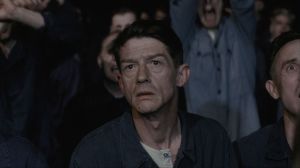
There are four new Batman comics being released on July 10, 2019. That doesn’t count the many issues that feature the character, in some fashion, or any of the collections of previously published work. Those offerings reflect a diverse array of takes on Batman, delivering grim-dark monologues and absurd multiversal conflicts, seemingly promising something for every specific taste. Comic readers have not wanted for Batman-related material in decades, but there is something to be said about quantity versus quality. Batman Universe #1, a six-issue miniseries collecting stories originally made available exclusively through Wal-Mart in 2018, reads like the only Batman comic in a world too full of Batman comics. It manages to capture the best parts of both its featured character and genre, delivering a story that is universal rather than overly specific, timeless rather than fleeting. It’s a tremendous issue of comics and long overdue in gracing the shelves of comic book stores (and digital storefronts) everywhere.
Videos by ComicBook.com
What makes Batman Universe #1 stand out as the Batman comic of the DC Rebirth era is how nimbly it integrates so many tones within a relatively small set of pages. The focus of this first issue rests squarely within the action and conspiracy modes of the superhero comic. It begins with Batman foiling the Riddler’s newest heist, before being tipped off to a much larger (and stranger) force beneath his enemy’s motivations. Emphasizing the spectacular superhero battles and detective work that are essential to the character doesn’t stop the title from delivering bits of humor, history, touching relationships, and some succinct introductions, though. Batman can exist as a brooding knight worried about the well-being of his city in one moment and growl at a genuinely funny quip from Alfred in the next, all without ever breaking the flow of this story. The greatest strength of Batman Universe #1 is in how it embraces the entirety of its concept, rather than emphasizing a narrow scope.

The first three pages provide something of a thesis statement for this approach and a perfect sample of how this issue operates. Eight panel grids emphasizing height (think Pax Americana #1) are used to introduce readers to this Batman in media res; they watch as he soars through the streets of Gotham City using some high-tech gadgets, some luck, and a lot of rope. It’s a thrilling sequence shown from Batman’s perspective that clarifies the adrenaline-filled rollercoaster of his work that comes before he even arrives on the scene. Read only as visuals, these two pages set up a big splash reveal perfectly—building tension with each new panel and releasing in one grand reveal. Throughout those first two pages there is plenty of dialogue, though. Jokes from residents who see Batman on the balcony and a slow distillation of the crisis-at-hand revealed in conversation with Alfred. The work of characterization and establishing tone is done efficiently without distracting from the action, and understands that the third page is best left silent for maximum impact. This thesis makes clear that artist Nick Derington and writer Brian Michael Bendis are more than solo superstars of the superhero comics scene, they are a dream team prepared to elevate one another’s work in collaboration.
Derington continues to pace each subsequent action sequence every bit as well as the first few pages. The big moments of the comic are delivered like punchlines with rising tension before a surprise delivery, often separated with a page turn. There’s never a moment without the appropriate establishing panel or right amount of space; cause and effect rule these sequences allowing readers to relish each new twist without even an errant thought of confusion. That’s particularly notable when you consider these fights occur in flashy night clubs and with an entire gang of stuntmen all dressed the same. The concepts are big, but Derington’s work never comes up short. Colorist Dave Stewart notably helps to isolate individual characters and clarify even the messiest of settings, ensuring that the delivery of these thrilling moments is never compromised.

It’s clear from the jump how Batman plays to Bendis’ strengths as a superhero writer. He is functionally the straight man in a world gone mad, making sense of absurd schemes and impossible feats (and providing a perfect sounding board for others’ jokes). That calm demeanor and willingness to engage with every idea on its own terms transforms him into a guiding hero, one who allows colorful personalities to show off and remain the readers favored perspective. His charm doesn’t come from flash or wit, but his incredible competence and understated personality. There’s a lot of character to be studied and Bendis has a patient approach in doing so, allowing others to jump into the spotlight and keep the story moving along the way.
Batman Universe #1 is the best Batman debut since the Rebirth relaunch, which means a lot considering how many Batman comics exist at any moment in modern comics history. That’s not because it is the only comic to “get” Batman, whatever that means; it’s because Batman Universe is a comic that embraces being a comic book. There’s a readiness to play with space, tone, and color across each new sequence. Action is delivered perfectly and the writing (no matter how funny or clever) values its place in a visual medium. Batman Universe isn’t about some grandiose philosophy or intense personal statement here—although the character’s history still holds meaning—this series is about telling the best Batman story imaginable, and that’s exactly what it is doing.
Published by DC Comics
On July 10, 2019
Written by Brian Michael Bendis
Art by Nick Derington
Colors by Dave Stewart
Letters by Josh Reed
Cover by Nick Derington








